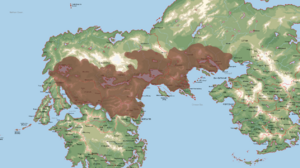Avernahkii
Avernahkii Khaganate | |
|---|---|
| 233–567 | |
|
Flag | |
 Avernhakii territory ~4th Century | |
| Capital | Varied |
| Common languages | Avernahkii Early Curonian Early Let |
| Religion | Varied |
| Government | Semi-nomadic empire |
| History | |
• Established | 233 |
• Disestablished | 567 |
| ISO 3166 code | [[Wikipedia:ISO 3166-2:Lua error in package.lua at line 80: module 'Module:ISO 3166/data/EE' not found.|Lua error in package.lua at line 80: module 'Module:ISO 3166/data/EE' not found.]] |
The Avernahkii were a nomadic Turkic people who established a major continental empire across northern Vinya between the 3rd and 6thCenturies CE. The Avernahkii Khaganate would become the largest Turkic empire formed in the history of Septentrion, stretching from the Northern Ocean coastline of Kolodoria to the West Gulf of Letnia.
The Avernahkii are first attested to in the 2nd Century BCE as having originated along the east coast of the Delfina Sea, before migrating across the Sedrinkan Plateau south into the Vyzhvan Steppe, where the became part of the Khorgruiq Confederation. At some point in the 1st Century CE they subjugated the Kupkans and had extended their presence westwards to the Liara River. Through uncertain means the Avernahkii became the dominant power in the Steppe by the 2nd Century under Khan Clejurric, likely by taking advantage of the political instability of the Khorgruiq. In the 3rd Century under Khan Ghorturin the Avernahkii crossed the Vastargyis Mountains and invaded the Katolaunian Fields, advancing all the way to the Satalice Valley. Isperia was incorporated into their growing domain around this time, and incursions into Selonia followed between 240-265 CE. By the start of the 4th Century they had conquered Bessarabia, Khalkhin, Tukayyid, and had reached as far as the Vytenis River. Between 312 to 320 they conquered the Deijan Kingdom around the Bay of Cullis, before expanding into the Voronezh Coastal Plain and the rest of Cherniya, absorbing other Curonian tribes. Sometime around 350 CE they invaded into Slavic lands around the modern city of Klipyevsk, an event which is considered to have helped trigger the start of Slavic migration eastward. The Slavs also however appeared to have halted Avernahkii expansion through a series of unrecorded battles west of Dimitrovgrad, bringing an end to their eastern advance by ~370.
Although primarily steered by military conquest, the Avernahkii also presided over significant volumes of trade between their territory and their neighbors. Common goods, textiles, lumber, amber, gold, silver, and tin were exchanged along the Khaganate's borders to neighboring Slavic, Yakut, and Ivernic states across Vinya. Due to its extensive territorial holdings, it was possible for weavers of the Buhrkata tribe on the coast of the Northern Ocean to have their wares transported to the Westgulf, board ships and land in Casaterra. Avernahkii officials and merchants became well known throughout Vinya for their skills in tradecraft and bargaining, a reputation which gradually expanded beyond the continent; findings of Avernahkii goods and coinage have been found as far as in Hallia and Abyaala.
Despite it's economic strength, the vitality of the Khaganate still rested primary on its military power. Like most nomadic empires the Avernahkii primarily fielded cavalry, both horse archers and lancers being the predominant forms associates with their style of warfare. Although primarily a cavalry force, the Avernahkii were also noted for fielding large numbers of foot soldiers, primarily archers and spear-wielding infantry. Although they had an extensive commercial society, the Avernahkii evidently lacked a strong cultural foundation of smelting and smithing, leaving both iron and bronze tools and weapons rare outside the aristocratic class. Additional troops levied from their subjugated peoples, Ivernics, Curonians, and Slavs, with their own distinct cultures of metallurgy, were usually better armed.
The Khagante itself was largely divided among these ethnic lines into Khanates, themselves ruled by family members (through blood or marriage) of the ruling Khagan. These Khanates and their ruling Khans enjoyed relative autonomy, in exchange for providing tribute and troops at the request of the Khagan, who roamed across various political/religious sites across the Steppe depending on the time of year. The Avernahkii themselves remained a mostly nomadic people despite their expansion, with most major urban areas under their domain inhabited by subjugated tribes. The Khaganate remained a stratified society, with ethnic Avernahkii at the top, followed by related and friendly Turkic tribes, then expanding outward to encompass non-Turkic populations. Like most Vinyan nomadic empires, the Avernhakii made little effort to impose their culture on those they conquered, but did endeavor to stamp out sects or groups they suspected of undermining their rule.
Like most Vinyan nomadic empires, the Khaganate also faced problems of governance; with their political systems having originated as a means of resolving disputes between clans over grazing territory, the Avernahkii had little institutional knowledge of how to manage a large, multi-ethnic empire. Rebellions by disgruntled tribes, uneasy internal political dynamics, and contentious relations with the various neighbors of the Khaganate contributed to an increasingly unstable level of centralized control, although this manifested in a range of ways, from outright civil war to increased autonomy for some regions, especially those far away from the central steppe. It was in the end, however, another Turkic tribe, the Gruykara, who originated on the shores of the Delfina Sea before migrating onto the Vzyvhan Steppe, where they engaged and defeated the Avernahkii, splintering their Khaganate into various successor states.
